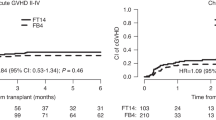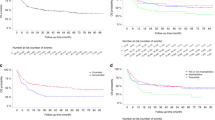Abstract
The high doses of chemotherapy used for the preparatory regimens before autologous blood or marrow stem cell transplantation leave patients at risk for neutropenic complications. The administration of filgrastim post transplant reduces the time to neutrophil recovery and therefore has become a standard practice at many institutions. In 2006, we implemented a practice change from filgrastim to pegfilgrastim. We present data on 164 consecutive patients (82 patients who received filgrastim compared with 82 patients who received pegfilgrastim) who received an auto-SCT between January 2006 and November 2007. Patients who received pegfilgrastim had faster engraftment (9.6 days compared with 10.9 days, P<0.0001), a lower incidence of febrile neutropenia (59% compared with 78%, P=0.015), as well as shorter hospital stay, fewer days of treatment with i.v. antibiotics (6.3 days compared with 9.6 days, P=0.006), and fewer radiographic tests, which translated to an estimated total cost savings of over $8000 per patient. Overall, there were no differences in toxicity with these two agents. We conclude that a single dose of pegfilgrastim is a safe and efficacious alternative to daily injections of filgrastim and can be a cost-effective approach in auto-SCT patients.
This is a preview of subscription content, access via your institution
Access options
Subscribe to this journal
Receive 12 print issues and online access
$259.00 per year
only $21.58 per issue
Buy this article
- Purchase on Springer Link
- Instant access to full article PDF
Prices may be subject to local taxes which are calculated during checkout




Similar content being viewed by others
References
Afessa B, Peters SG . Major complications following hematopoietic stem cell transplantation. Semin Respir Crit Care Med 2006; 27: 297–309.
Hamalainen S, Kuittinen T, Matinlauri I, Nousiainen T, Koivula I, Jantunen E . Severe sepsis in autologous stem cell transplant recipients: microbiological aetiology, risk factors and outcome. Scand J Infect Dis 2009; 41: 14–20.
Mossad SB, Longworth DL, Goormastic M, Serkey JM, Keys TF, Bolwell BJ . Early infectious complications in autologous bone marrow transplantation: a review of 219 patients. Bone Marrow Transplant 1996; 18: 265–271.
Richard S, Schuster MW . Stem cell transplantation and hematopoietic growth factors. Curr Hematol Rep 2002; 1: 103–109.
Trivedi M, Martinez S, Corringham S, Medley K, Ball ED . Optimal use of G-CSF administration after hematopoietic SCT. Bone Marrow Transplant 2009; 43: 895–908.
Bhana N . Granulocyte colony-stimulating factors in the management of chemotherapy-induced neutropenia: evidence based review. Curr Opin Oncol 2007; 19: 328–335.
Hornedo J, Sola C, Solano C, Lopez JJ, Alonso S, Lluch A et al. The role of granulocyte colony-stimulating factor (G-CSF) in the post-transplant period. Bone Marrow Transplant 2002; 29: 737–743.
Lee SM, Radford JA, Dobson L, Huq T, Ryder WD, Pettengell R et al. Recombinant human granulocyte colony-stimulating factor (filgrastim) following high-dose chemotherapy and peripheral blood progenitor cell rescue in high-grade non-Hodgkin's lymphoma: clinical benefits at no extra cost. Br J Cancer 1998; 77: 1294–1299.
Smith TJ, Khatcheressian J, Lyman GH, Ozer H, Armitage JO, Balducci L et al. 2006 update of recommendations for the use of white blood cell growth factors: an evidence-based clinical practice guideline. J Clin Oncol 2006; 24: 3187–3205.
Crawford J . Once-per-cycle pegfilgrastim (Neulasta) for the management of chemotherapy-induced neutropenia. Semin Oncol 2003; 30 (4 Suppl 13): 24–30.
Molineux G . Pegfilgrastim: using pegylation technology to improve neutropenia ssupport in cancer patients. Anticancer Drugs 2003; 14: 259–264.
Yowell SL, Blackwell S . Novel effects with polyethylene glycol modified pharmaceuticals. Cancer Treat Rev 2002; 28 (Suppl A): 3–6.
Martino M, Pratico G, Messina G, Irrera G, Massara E, Console G et al. Pegfilgrastim compared with filgrastim after high-dose melphalan and autologous hematopoietic peripheral blood stem cell transplantation in multiple myeloma patients. Eur J Haematol 2006; 77: 410–415.
Staber PB, Holub R, Linkesch W, Schmidt H, Neumeister P . Fixed-dose single administration of Pegfilgrastim vs daily Filgrastim in patients with haematological malignancies undergoing autologous peripheral blood stem cell transplantation. Bone Marrow Transplant 2005; 35: 889–893.
Jagasia MH, Greer JP, Morgan DS, Mineishi S, Kassim AA, Ruffner KL et al. Pegfilgrastim after high-dose chemotherapy and autologous peripheral blood stem cell transplant: phase II study. Bone Marrow Transplant 2005; 35: 1165–1169.
Vanstraelen G, Frere P, Ngirabacu MC, Willems E, Fillet G, Beguin Y . Pegfilgrastim compared with Filgrastim after autologous hematopoietic peripheral blood stem cell transplantation. Exp Hematol 2006; 34: 382–388.
Porrata LF, Gertz MA, Inwards DJ, Litzow MR, Lacy MQ, Tefferi A et al. Early lymphocyte recovery predicts superior survival after autologous hematopoietic stem cell transplantation in multiple myeloma or non-Hodgkin lymphoma. Blood 2001; 98: 579–585.
Yoong Y, Porrata LF, Inwards DJ, Ansell SM, Micallef IN, Litzow MR et al. The effect of absolute lymphocyte count recovery kinetics on survival after autologous stem cell transplantation for non-Hodgkin's lymphoma. Leuk Lymphoma 2005; 46: 1287–1294.
Hiwase DK, Hiwase S, Bailey M, Bollard G, Schwarer AP . Higher infused lymphocyte dose predicts higher lymphocyte recovery, which in turn, predicts superior overall survival following autologous hematopoietic stem cell transplantation for multiple myeloma. Biol Blood Marrow Transplant 2008; 14: 116–124.
Ballestrero A, Boy D, Gonella R, Miglino M, Clavio M, Barbero V et al. Pegfilgrastim compared with filgrastim after autologous peripheral blood stem cell transplantation in patients with solid tumours and lymphomas. Ann Hematol 2008; 87: 49–55.
AMCP Guide to Pharmaceutical Payment Methods. Update (Version 2.0). J Manag Care Pharm 2009; 15 (Suppl A): S3–S57 (quiz S58–S61).
Acknowledgements
We thank all of the dedicated staff involved in the outstanding care of the patients undergoing auto-SCT at Memorial Hospital. We also thank Kris Kauffman for his time and contributions in data collection and management.
Author information
Authors and Affiliations
Corresponding author
Ethics declarations
Competing interests
Dr Stephen Nimer has received honorarium from Amgen for serving as a consultant. Dr Nelly Adel has served as a speaker for several continuous education programs sponsored by grants from Amgen.
Rights and permissions
About this article
Cite this article
Mathew, S., Adel, N., Rice, R. et al. Retrospective comparison of the effects of filgrastim and pegfilgrastim on the pace of engraftment in auto-SCT patients. Bone Marrow Transplant 45, 1522–1527 (2010). https://doi.org/10.1038/bmt.2009.373
Received:
Revised:
Accepted:
Published:
Issue Date:
DOI: https://doi.org/10.1038/bmt.2009.373
Keywords
This article is cited by
-
Low-dose peripheral blood stem cell graft after high-dose chemotherapy - an evaluation of hematopoietic reconstitution
BMC Cancer (2020)
-
Pegfilgrastim improves the outcomes of mobilization and engraftment in autologous hematopoietic stem cell transplantation for the treatment of multiple myeloma
Annals of Hematology (2020)
-
Pegfilgrastim: More Cost Effective and Equally Efficacious Option as Compared to Filgrastim in Autologous Stem Cell Transplant
Indian Journal of Hematology and Blood Transfusion (2019)
-
Efficacy of deferred dosing of granulocyte colony-stimulating factor in autologous hematopoietic transplantation for multiple myeloma
Bone Marrow Transplantation (2014)
-
Cost Effectiveness of Pegfilgrastim Versus Filgrastim After High-Dose Chemotherapy and Autologous Stem Cell Transplantation in Patients with Lymphoma and Myeloma
Applied Health Economics and Health Policy (2013)



